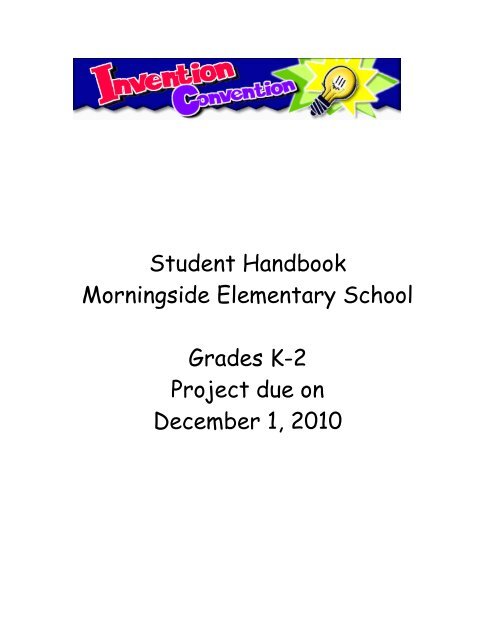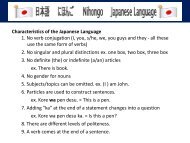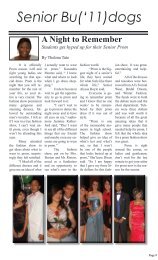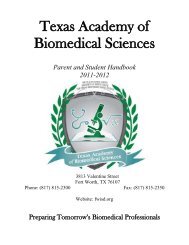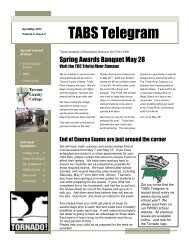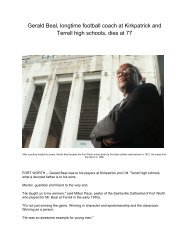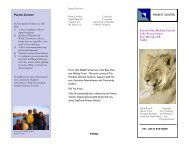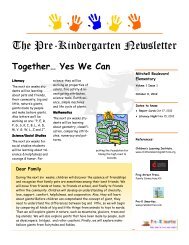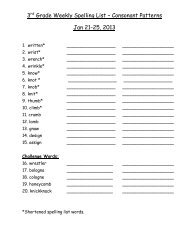invention convention - Fort Worth ISD Schools
invention convention - Fort Worth ISD Schools
invention convention - Fort Worth ISD Schools
Create successful ePaper yourself
Turn your PDF publications into a flip-book with our unique Google optimized e-Paper software.
Student Handbook<br />
Morningside Elementary School<br />
Grades K-2<br />
Project due on<br />
December 1, 2010
Inventor’s Timeline<br />
Please note there are NO groups or Class projects in Invention Convention; it is all individual<br />
projects based on an <strong>invention</strong> or an innovation of an existing product.<br />
November 1, 2010 –Inventor’s Handbook, Rubric, and Timeline distributed.<br />
Rubric must be signed by parent and returned for documentation. The<br />
rubric will be returned to student the following day.<br />
November 2, 2010 – Student returns rubric with parent signature to class.<br />
November 3, 2010 – Invention Log distributed; required to make one entry<br />
every day (including weekends); students will receive a grade based on<br />
completeness on scheduled and unscheduled log checks in class.<br />
November 8, 2010 – Students should select their best idea and begin<br />
research, making a detailed diagram of <strong>invention</strong>/innovation with all<br />
parts labeled, and begin making model of <strong>invention</strong>/innovation.<br />
December 1, 2010 – The Tri fold board presentation, model of<br />
<strong>invention</strong>/innovation, and <strong>invention</strong> log are due in class. There will be<br />
no excuses accepted.<br />
December 2, 2010 – Campus Judging Day<br />
December 3, 2010 – Winner’s information sent to FW<strong>ISD</strong> office<br />
December 9, 2010 – District Invention Convention at Billingsley Field House<br />
– public may view projects from 4:00 to 6:00 pm.
The project does require a Tri-fold board. Please note the board<br />
can be re-covered and re-used for Science Fair (which are<br />
also school required projects this year for all students).<br />
The project board must have a border. These can be<br />
purchased border, ribbon, hand-painted or sponged painted<br />
borders or be creative!<br />
Parents, if you have any questions, please write your teacher<br />
a note, email, or call the school.<br />
Happy Inventing and Enjoy!<br />
Caroline Hill<br />
SIP Coordinator
I have seen the Inventor’s Handbook and Inventor’s timeline. I<br />
am aware that my child has a project due on December 1, 2010.<br />
This project will receive grades in Science, Social Studies,<br />
Language Arts, and Reading for the third six week grading period.<br />
Child’s name: _______________________<br />
Parent’s signature: ______________________<br />
Date: _____________________________
The Invention Convention Steps for Students<br />
Grades K-2<br />
Can you invent something? Can you think of an idea or <strong>invention</strong> that will help people? Read the<br />
five steps below. They will help you to become an inventor. Then<br />
bring your idea or <strong>invention</strong> to the Invention Convention.<br />
Step 1: Learning About Inventors<br />
Learn about inventors. Read about them in books.<br />
Talk to people about them.<br />
Step 2: Finding an Idea<br />
Think about something people need in order to make<br />
life better. Talk to people about something they would<br />
like to see changed. Then tell your teacher about it on a<br />
special sheet of paper called "My New Idea."<br />
Step 3: Research and Planning<br />
Use your plan to make an <strong>invention</strong>. Or write about<br />
how your <strong>invention</strong> would help to solve a problem. Be<br />
sure to follow science safety rules when you make an<br />
<strong>invention</strong>.<br />
Step 4: Developing and Testing<br />
Test your <strong>invention</strong> or your plan. Make sure it works<br />
and is safe to use. Tell about your <strong>invention</strong>. You may<br />
want to draw a picture of it. Use the sheet called My<br />
Invention.<br />
Step 5: Attending the Invention Convention<br />
Get your <strong>invention</strong> or plan ready for the Invention<br />
Convention. Try to make it look as good as you can.<br />
Learn all you can about how it works and what it is<br />
good for. Bring it to the Invention Convention. Be<br />
ready to answer questions.
Examples of Student Inventions<br />
“I can't think of anything to invent!” is a complaint teachers sometimes hear when<br />
students begin the inventing process. You can encourage students by discussing<br />
some of the <strong>invention</strong>s listed here that students have created over the past few<br />
years.<br />
a device that cleans gutters<br />
a plastic product that holds a book while you eat<br />
a rain poncho designed for use when riding a bicycle<br />
a lunch-box alarm that goes off when an unauthorized person opens the<br />
box<br />
a bird feeder that protects feed from wind and rain<br />
a new board game<br />
a newly designed bottle opener<br />
a toothpaste cap that minimizes waste and mess<br />
a device that prevents blisters from forming on hands when raking,<br />
shoveling, or sweeping<br />
a billfold that organizes money by denomination for blind people<br />
a new candy bar<br />
a new type of swing set<br />
clothing tags to help match and coordinate clothes<br />
a dog collar that lights up at night<br />
a bedspread that zips down the middle<br />
safety suspenders that light up at night for joggers or bikers<br />
a lock for a folding door<br />
a new type of ice cream container that minimizes mess<br />
a new type of rake that allows you to pick up leaves without bending over<br />
an infant support that prevents a very young baby from falling over<br />
a robot that distributes and collects student papers<br />
a glove with a light for signaling turns when riding a bike at night<br />
a better, more comfortable swing set<br />
a device to hold objects for disabled people who use a walker<br />
a computer program that includes graphics and music for entertaining<br />
children aged 3 months to 4 years<br />
a child's seat that fits a shopping cart<br />
a hearing-aid guard<br />
a mailbox alert device that signals when mail has been delivered to a<br />
roadside mailbox<br />
a leg cast sock to keep toes warm<br />
tapeless wrapping paper<br />
a comforter for cats<br />
an outside house light that flashes to signal police, firemen, or other<br />
helpers as to which house made a call for assistance
a computer program that catalogs videotapes<br />
an eyeglass defogging device<br />
a device that makes it easier to swallow pills<br />
a drying rack for gloves<br />
a liquid that covers fade marks on blue jeans<br />
a light switch for young children<br />
a chocolate-candy device that prevents ice cream cones from dripping<br />
a bus-stop night light
Resources<br />
Books<br />
Students can be encouraged and stimulated by reading about inventors and<br />
<strong>invention</strong>s. The books listed below contain many illustrations and ideas that can<br />
help to get students started on their way toward inventing a new product or<br />
process.<br />
Caney, Steven. Steven Caney's Invention Book. New York: Workman Publishing<br />
Co., 1985.<br />
Dunn, Susan and Rob Larson. Design Technology: Children's Engineering.<br />
Falmer Press, 1990. (Grades K-6)<br />
Eichelberger, Barbara and Connie Larson. Constructions for Children: Projects in<br />
Design Technology. Available from Dale Seymour Publications. (Grades 1-4)<br />
Jones, Foltz Charlotte. Mistakes That Worked: 40 Familiar Inventions and How<br />
They Came to Be. New York: Doubleday, 1991.<br />
Karnes, Francis, Suzanne H. Bean, and Rose Mary Wallner.Girls and Young<br />
Women Inventing: Twenty True Stories About Inventors Plus How You Can Be<br />
One Yourself. Free Spirit, 1995. (Grades 3-6)<br />
Kramer, Stephen P. How to Think Like a Scientist: Answering Questions by the<br />
Scientific Method. New York: Thomas Y. Crowell, 1987. (Grades 2-4)<br />
McCormack, Alan J. Inventor's Workshop. Belmont, CA: Pitman Learning, Inc.<br />
1981. (Grades 2-6)<br />
McKissack, Pat and Frederick L. McKissack. African-American Inventors.<br />
Millbrook Press, 1994. (Grades 4-7)<br />
Rasmussen, Greta. WakerUppers: A Spirited Collection of Thinking Activities.<br />
Available from Dale Seymour Publications. (Grades 2-6)<br />
Rowland, Dr. Elizabeth and Dr. Leonard Molotsky. Resource of Creative and<br />
Inventive Activities. Richardson, TX: National Inventive Thinking Association,<br />
1994. (For teachers)<br />
Sobey, Ed. Inventing Stuff. Available from Dale Seymour Publications. (Grades 5<br />
and up)
Stanish, Bob. The Un<strong>convention</strong>al Invention Book. Carthage, IL: Good Apple,<br />
Inc., 1981.<br />
Striker, Susan. Build a Better Mousetrap. New York: Holt, Rinehart & Winston,<br />
1983.<br />
Taylor, Barbara. Be an Inventor. New York: Harcourt Brace, 1987. (Grades 3 and<br />
up)<br />
Tucker, Tom and Richard Loehle. Brainstorm: The Stories of Twenty American<br />
Kid Inventors. Farrar Straus & Giroux, 1995. (Grades 4-7)<br />
Yenne, Bill. 100 Inventions That Shaped World History. Bluewood Books, 1993.<br />
(Grades 3-6)<br />
Book and CD-ROM<br />
Macaulay, David. The Way Things Work. Dorling Kindersley Publishing.<br />
Available from Dale Seymour Publications. (Grades 5 and up)<br />
Web Links<br />
Invention Dimension (tm) - http://web.mit.edu/afs/athena.mit.edu/org/i/invent/<br />
Inventure Place, National Inventors Hall of Fame – http://www.invent.org/<br />
EurekAlert! - http://www.eurekalert.org/<br />
By Kids For Kids Young Inventors and Kid's How to Invent -<br />
http://www.bkfk.com/
My New Idea (K-2 grades)<br />
The date today is<br />
______________________________________________________.<br />
My name is<br />
______________________________________________________.<br />
I am in grade<br />
______________________________________________________.<br />
The name of my school is<br />
______________________________________________________.<br />
The address of my school is<br />
______________________________________________________.<br />
The telephone number of my school is<br />
______________________________________________________.<br />
I am going to invent<br />
_______________________________________________________<br />
_______________________________________________________<br />
_______________________________________________________<br />
_______________________________________________________<br />
I will need<br />
_______________________________________________________<br />
_______________________________________________________<br />
_______________________________________________________<br />
_______________________________________________________<br />
Here is a picture of how it might look:
My Invention (K-2 grades)<br />
The date today is<br />
______________________________________________________.<br />
My name is<br />
_______________________________________________________<br />
I am in grade<br />
______________________________________________________.<br />
This is the problem I found.<br />
_______________________________________________________<br />
_______________________________________________________<br />
_______________________________________________________<br />
I have invented<br />
_______________________________________________________<br />
______________________________________________________<br />
_______________________________________________________<br />
_______________________________________________________<br />
It is helpful because<br />
_______________________________________________________<br />
_______________________________________________________<br />
_______________________________________________________<br />
_______________________________________________________<br />
My <strong>invention</strong> works like this.<br />
_______________________________________________________<br />
_______________________________________________________<br />
_______________________________________________________<br />
_______________________________________________________<br />
I believe my <strong>invention</strong> is a brand new idea.<br />
I would like to show my <strong>invention</strong> at the Invention Convention.<br />
Signed<br />
_______________________________________________________<br />
Witness: (teacher)<br />
_______________________________________________________<br />
Witness: (parent)<br />
_______________________________________________________
Research and Development Date_________________<br />
(K-2 Grades)<br />
Student Inventor<br />
_______________________________________________________<br />
(Last name) (First name)<br />
Answer each of the following questions briefly to provide a short<br />
overall description of the research and development work done on<br />
your <strong>invention</strong>. Use additional pages if necessary. Be sure your<br />
answers are readable and in complete sentences.<br />
1. What did I read that helped me with my <strong>invention</strong>?<br />
_______________________________________________________<br />
_______________________________________________________<br />
2. Who did I talk to about solving problems and planning properly?<br />
_______________________________________________________<br />
_______________________________________________________<br />
3. What materials did I use?<br />
_______________________________________________________<br />
_______________________________________________________<br />
4. How did I control the cost of my <strong>invention</strong>?<br />
_______________________________________________________<br />
_______________________________________________________<br />
5. What steps did I follow; what problems did I have to overcome?<br />
_______________________________________________________<br />
_______________________________________________________<br />
6. How did I test my <strong>invention</strong> or process?<br />
_______________________________________________________
<strong>Fort</strong> <strong>Worth</strong> Independent School District<br />
INVENTION CONVENTION<br />
Written Description<br />
(To be completed by the Student)<br />
INVENTION NAME:<br />
______________________________________________<br />
What is the need or problem<br />
solved?_____________________________________________________________________<br />
___________________________________________________________________________<br />
___________________________________________________________________________<br />
___________________________________________________________________________<br />
What research did you do on your <strong>invention</strong>?<br />
___________________________________________________________________________<br />
___________________________________________________________________________<br />
___________________________________________________________________________<br />
___________________________________________________________________________<br />
___________________________________________________________________________<br />
How does it<br />
work?______________________________________________________________________<br />
___________________________________________________________________________<br />
___________________________________________________________________________<br />
___________________________________________________________________________<br />
How is it made?<br />
___________________________________________________________________________<br />
___________________________________________________________________________<br />
___________________________________________________________________________<br />
___________________________________________________________________________<br />
___________________________________________________________________________<br />
Cost:<br />
___________________________________________________________________________<br />
___________________________________________________________________________<br />
You w ill be judged on content, expression of idea, and legibility. *Grades K-3 only: Written<br />
Description will be judged for content only. Teachers or parents may assist by writing the<br />
Written Description; however, IDEAS AND CONTENT MUST BE CHILD’S OWN.
<strong>Fort</strong> <strong>Worth</strong> Independent School District<br />
INVENTION CONVENTION<br />
DRAWING OF INVENTION<br />
INVENTION NAME: _________________________________________<br />
Be sure to draw and label all parts. Students may use pens, crayons, or<br />
magic markers for drawing. Suggestion: Colors make your <strong>invention</strong><br />
come alive!<br />
Note: Drawing must be completed entirely by the student! You will be scored on<br />
how completely you illustrate your <strong>invention</strong>. Be sure to label all parts and make<br />
your drawing as attractive and useful as possible.
HERE’S SOMETHIN G ELSE I WANT YOU TO KNOW ABOUT MY<br />
INVENTION<br />
Include any information you want the judges to know about your<br />
<strong>invention</strong> that wasn’t included in the Written Description. You might<br />
want to describe any special research you did, any marketing/ advertising<br />
plans you developed, and whether you have actually tried out your<br />
<strong>invention</strong>.<br />
FORT WORTH INDEPENDENT SCHOOL DISTRICT
INVENTION CONVENTION<br />
Official Judging Form<br />
JUDGING CRITERIA: POINTS POSSIBLE<br />
ORIGINALITY<br />
The innovation or <strong>invention</strong> shows uniqueness,<br />
novelty, and creative thinking. Presentation of board. 20<br />
USEFULNESS<br />
The innovation or <strong>invention</strong> solves a<br />
problem or need and has a market. 20<br />
WRITTEN DESCRIPTION*<br />
TH ILLUSTRATION<br />
The description of the innovation or <strong>invention</strong><br />
clearly explains the <strong>invention</strong>, is legible, and<br />
expresses the ideas of the inventor. The illustration<br />
is a clear, attractive visual explanation of the<br />
student’s idea. All parts are labeled and the<br />
illustration is complete. 30<br />
RESEARCH PERFORMED<br />
The written description reflects the quality and<br />
comprehensiveness of the student’s research.<br />
“Something else I want Judges to know.” 30<br />
TOTAL POINTS 100<br />
*Grades K-3 only: Written Description section will be judged for content only. Teachers or parents may<br />
assist the child by writing or typing the Written Description; however, ideas and content must be the child’s<br />
own.
INVENTION CONVENTION<br />
RULES AND REGULATIONS<br />
1. The only items that may be submitted by students are <strong>invention</strong>s and innovations. Inventions<br />
are defined as useful things, which have not previously been made. Inventions and innovations<br />
are defined as new products, processes or services or an improvement of existing products,<br />
processes or services. It has to be an improvement on how the item works.<br />
2. A student must submit a signed parent permission slip allowing him/her to participate.<br />
3. Students should obtain an official FW<strong>ISD</strong> Invention Convention entry form from their<br />
teachers.<br />
4. Submit the completed entry form to the classroom teacher, along with a written description,<br />
drawing (Forms 4A, 4B, and 4C), and model.<br />
5. The school selects one winning class project from K-2 nd grade. They also select three<br />
winning individual projects from the primary grades (K-2), and three winning individual projects<br />
from the intermediate grade levels (3-5). Middle schools may submit one entry from each<br />
Science class participating in the school-based contest or up to five entries.<br />
Each of these winners may enter the District Invention Convention competition. 1 st place<br />
grade level winners may also enter the Invent America competition. Any projects done by two or<br />
more students, except for the class project, will not be allowed to compete. All projects that<br />
are entered in the District Competition must be on triptychs—no poster boards will be accepted.<br />
6. Students will submit a model of their <strong>invention</strong> with the official entry form signed by the<br />
building level coordinators. Completed models may be no larger that 3’ by 3’ by 3’. In grades<br />
K-3 only the Written Description will be judged for content only. Displays must include Written<br />
Description and Drawing of the Invention. NO NAMES OR PICTURES OF THE<br />
STUDENTS AND/OR FAMILY MEMBERS MAY BE ON THE DISPLAY. This will cause the<br />
project to be removed from the competition. This is to ensure that all projects are judged<br />
fairly. It is highly recommended that all projects have a log book where all rough drafts can be<br />
viewed. This may be placed in front of the object. (Please be sure there are NO NAMES.)<br />
7. All entries will be judged based upon the following criteria:<br />
A. Originality<br />
B. Usefulness<br />
C. Written Description<br />
D. Research<br />
E. Illustration<br />
8. It is clearly and fully understood that the student and his/her parent(s) or legal guardian(s) will<br />
hold harmless the <strong>Fort</strong> <strong>Worth</strong> Independent School District and its designees for any property loss<br />
or injury generated by or resulting from the entry.
9. NO ENTRY MAY EXCEED A SPENDING LIMIT OF $20.00. All costs should be<br />
documented in the student’s log and the Written Description page.<br />
10. All decisions made by the judges are absolute and final.
INVENTION CONVENTION<br />
Reglas<br />
1. Los estudiantes solamente podrán presentar cosas que son invenciones o innovaciones.<br />
Invenciones se define domo cosas que son utiles y que nunca han sido creadas.<br />
Innovaciones se define como cosas que son productos o servicios o procesos nuevos o el<br />
mejoramiento de productos, servicios o processos que ya existen. Esto no incluye hacer<br />
algo ver se diferente o major. Tiene que ser un mejoramiento en como trabaja el<br />
producto.<br />
2. Los estudiantes tienen que entregar permiso escrito de sus padres que el estudiante<br />
puede participar.<br />
3. El estudiante tiene que obtener la solicitad oficial de fort <strong>Worth</strong> <strong>ISD</strong> Invention Convencion<br />
de se maestro.<br />
4. El estudiante tiene que entragar la solicitud official al maestro de su salon incluyendo una<br />
descripción escrita, un dibujo, y un modelo.<br />
5. Cada escuela seleccionará un proyecto ganador de los grados K-2. Tambien<br />
seleccionarán tres de los grados primaries (K-2) y tres proyectos de los grados<br />
intermedios (3-5). Escuelas secundarias pueden someter una entrada por cada clase de<br />
ciencias. Cada ganador puede entrar a la competición de “Invent America Contest” y la<br />
competición del distrito de <strong>Fort</strong> <strong>Worth</strong> “Invention Convention”. Cualquier proyecto de los<br />
grados 3-7 hecho por dos estudiantes no sera permitidos competir. Todos los<br />
proyectos entrados a la competición del distrito tienen que estar un triptych, cartelones no<br />
sera acceptados.<br />
6. Los estudiantes van a someter un modelo de su invención con una forma de solicitud<br />
oficial firmada por el cordinador de la escuela. Los modelos no pueden ser mas grandes<br />
de 3’ por 3’ por 3’. (Lo sentimos si esto causa una inconveniencia, pero solo hay cierto<br />
espacio par las exhibiciónes.) En los grados K-3 solamente el contenico de descripción<br />
sera juzgado. La exhibición debe incluir una descripción escrita y un dibujo de la<br />
invención. Nombres o fotografias de los estudiante y/o familiars no deben estar en la<br />
exhibición. Esto causara que el proyecto sea removido de al competencia. Esto es para<br />
aseguara todos los proyectos sean juzgados imparcialmente.<br />
7. Todos los proyectos serán juzgados con el siguiente criterio:<br />
A. Originalidad<br />
B. Utilidad<br />
C. Descripción escrita<br />
D. Investigación<br />
E. Ilustración<br />
8. El distrio escolar de <strong>Fort</strong> <strong>Worth</strong> y sus designados no serán responsables por daños o<br />
heridas por
causa de la participación del estudiante.<br />
9. LAS ENTRADAS NO PUEDEN EXCEDER MAS DE $20.00 EN GASTOS. Todos los<br />
gastos deben ser documentados en el cuaderno de estudiante y en la pagina escrita de<br />
descripciónes.<br />
10. Todas las decisions hechas por los juezas son absolutas y finales.


